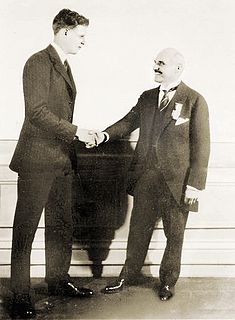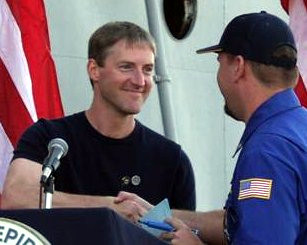
The Coupe d'Aviation Maritime Jacques Schneider, commonly called the Schneider Trophy or Schneider Prize, was a trophy awarded annually to the winner of a race for seaplanes and flying boats. The Schneider Trophy is now held at the Science Museum, South Kensington, London.

The Orteig Prize was a reward offered to the first Allied aviator(s) to fly non-stop from New York City to Paris or vice versa. Several famous aviators made unsuccessful attempts at the New York–Paris flight before the relatively unknown American Charles Lindbergh won the prize in 1927 in his aircraft Spirit of St. Louis. However a number of lives were lost by men who were competing to win the prize. Six men died in three separate crashes, and another three were injured in a fourth crash. The Prize occasioned considerable investment in aviation, sometimes many times the value of the prize itself, and advancing public interest and the level of aviation technology.
Transatlantic crossings are passages of passengers and cargo across the Atlantic Ocean between Europe or Africa and the Americas. The majority of passenger traffic is across the North Atlantic between Western Europe and North America. Centuries after the dwindling of sporadic Viking trade with Markland, a regular and lasting transatlantic trade route was established in 1566 with the Spanish West Indies fleets, following the Voyages of Christopher Columbus.

The Spirit of St. Louis is the custom-built, single engine, single-seat, high wing monoplane that was flown by Charles Lindbergh on May 20–21, 1927, on the first solo nonstop transatlantic flight from Long Island, New York, to Paris, France, for which Lindbergh won the $25,000 Orteig Prize.

British aviators John Alcock and Arthur Brown made the first non-stop transatlantic flight in June 1919. They flew a modified First World War Vickers Vimy bomber from St. John's, Newfoundland, to Clifden, Connemara, County Galway, Ireland. The Secretary of State for Air, Winston Churchill, presented them with the Daily Mail prize for the first crossing of the Atlantic Ocean by aeroplane in "less than 72 consecutive hours". A small amount of mail was carried on the flight, making it the first transatlantic airmail flight. The two aviators were awarded the honour of Knight Commander of the Most Excellent Order of the British Empire (KBE) a week later by King George V at Windsor Castle.
This is a list of aviation-related events from 1927:
A transatlantic flight is the flight of an aircraft across the Atlantic Ocean from Europe, Africa, or the Middle East to North America, Central America, or South America, or vice versa. Such flights have been made by fixed-wing aircraft, airships, balloons, and other aircraft.

Erik Charles Lindbergh is an aviator, adventurer, and an artist. He is the grandson of pioneering aviator Charles Lindbergh, the first person to fly non-stop between New York and Paris in 1927. In 2002 Erik Lindbergh honored the 75th anniversary of his grandfather's historic flight by retracing the journey in his own single-engine aircraft. The journey was documented by the History Channel, raised over one million dollars for three charities, garnered half a billion media impressions for the X PRIZE Foundation and prompted a call from United States President George W. Bush for inspiring the country after the tragedy of September 11.

The Bloch MB.160 was a fourteen-seat French airliner intended for use in the French African colonies. Three were built and two entered service with Régie Air-Afrique at the start of World War II. Developments included the Bloch MB.162 bomber which was too late for service and the Sud-Est SE.161 Languedoc, one hundred of which were built post-war.
The NC-4 Medal is a military decoration that was authorized by the United States Congress in 1929 to commemorate the 1919 trans-Atlantic crossing by the members of the NC-4 mission. Originally awarded as a non-wearable table medal, in 1935 a wearable version of the medal was subsequently authorized. A commemorative medal, the NC-4 Medal was a one-time award, and does not currently appear on U.S. Navy award precedence charts.

Ludwik Idzikowski was a Polish military aviator. He died during a transatlantic flight trial.

The Spirit of St. Louis is a 1957 aviation biography film in CinemaScope and WarnerColor from Warner Bros., directed by Billy Wilder, produced by Leland Hayward, that stars James Stewart as Charles Lindbergh. The screenplay was adapted by Charles Lederer, Wendell Mayes, and Billy Wilder from Lindbergh's 1953 autobiographical account of his historic flight, which won the Pulitzer Prize in 1954.

Charles Albert Levine was the first passenger aboard a transatlantic flight. He was ready to cross the Atlantic to claim the Orteig prize but a court battle over who was going to be in the airplane allowed Charles Lindbergh to leave first.

The Blériot 5190 was a French transatlantic mail plane of the 1930s, a large parasol-wing monoplane flying boat. It was of slightly unusual design, with a low-profile hull and the crew compartment housed in the thick pylon that supported the wing. The four engines were arranged with three along the leading edge of the wing, and the fourth on the centreline of the trailing edge. It was constructed for a French government contract to carry airmail to South America.

L'Oiseau Blanc was a French Levasseur PL.8 biplane that disappeared in 1927, during an attempt to make the first non-stop transatlantic flight between Paris and New York City to compete for the Orteig Prize. The aircraft was flown by French World War I aviation heroes Charles Nungesser and François Coli. The aircraft took off from Paris on 8 May 1927 and was last seen over Ireland. Less than two weeks later, Charles Lindbergh successfully made the New York–Paris journey and claimed the prize, flying the Spirit of St. Louis.
Commandant Maurice Albert Alfred Jean Arnoux was a French World War I flying ace credited with five aerial victories. He returned to flying fighter planes during the early days of World War II, but was killed in action in 1940.

The Breguet 470 Fulgur was a French airliner of the 1930s. Only a single example of the twin-engined monoplane was built, this being sold to the Spanish Republican government during the Spanish Civil War.

The sole Wright-Bellanca WB-2, named Columbia, Miss Columbia, and later Maple Leaf, was the second in a series of aircraft designed by Giuseppe Mario Bellanca, initially for Wright Aeronautical then later Columbia Aircraft Corp.

The Levasseur PL.8 was a single engine, two-seat long-distance record-breaking biplane aircraft modified from an existing Levasseur PL.4 carrier-based reconnaissance aircraft produced in France in the 1920s. Levasseur built the aircraft in 1927, specifically for pilots Charles Nungesser and François Coli for a transatlantic attempt to win the Orteig Prize. Only two examples of the type were built, with the first PL.8-01 named L'Oiseau Blanc, that gained fame as Nungesser and Coli's aircraft.
















